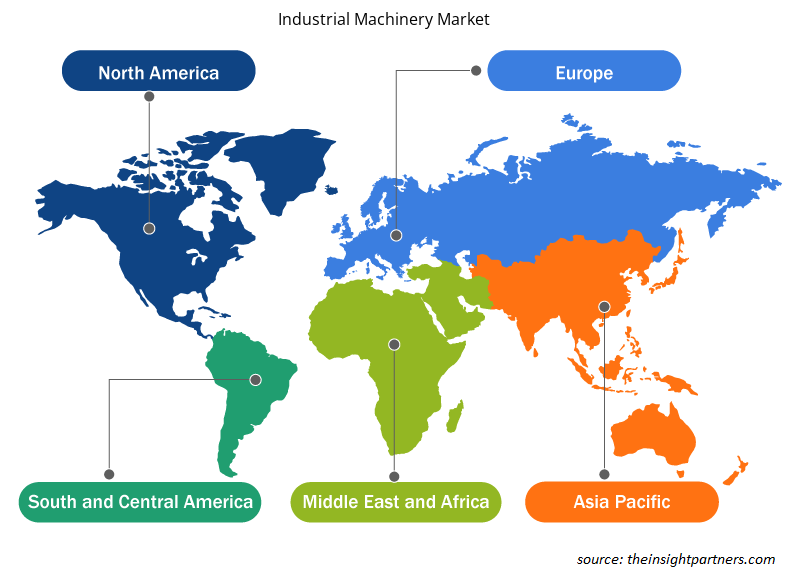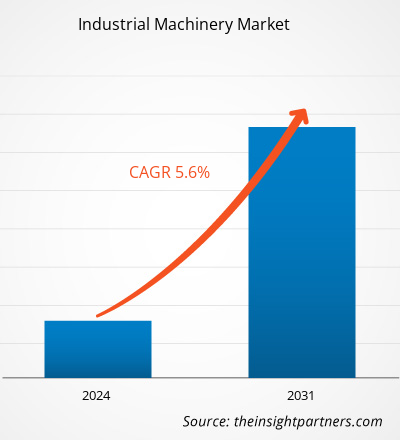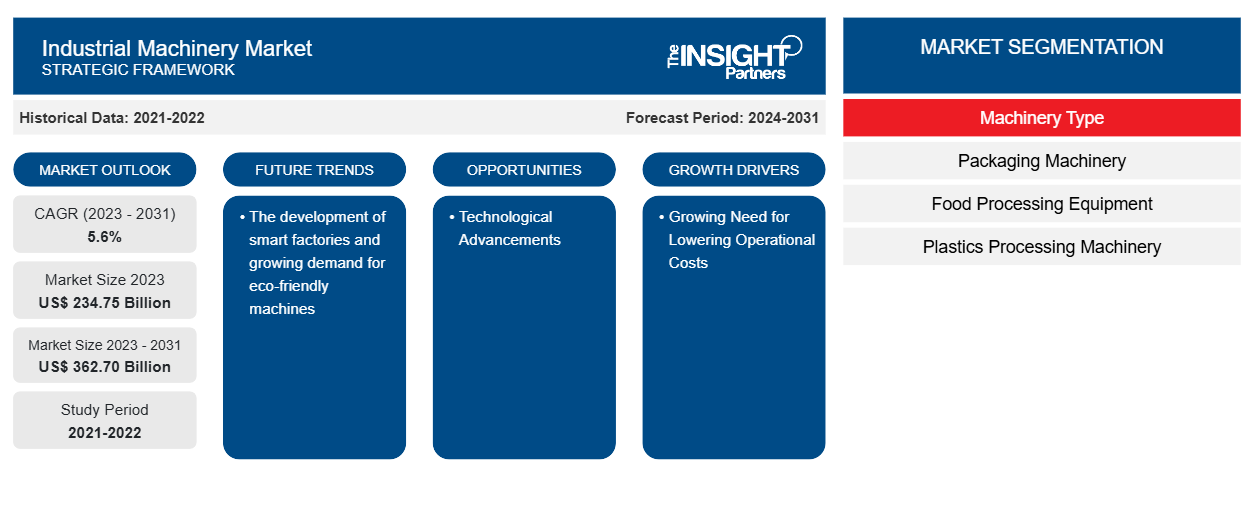من المتوقع أن يصل حجم سوق الآلات الصناعية إلى 362.70 مليار دولار أمريكي بحلول عام 2031 من 234.75 مليار دولار أمريكي في عام 2023. ومن المتوقع أن يسجل السوق معدل نمو سنوي مركب بنسبة 5.6٪ في الفترة 2023-2031. ومن المرجح أن يظل تطوير المصانع الذكية والطلب المتزايد على الآلات الصديقة للبيئة اتجاهًا رئيسيًا في سوق الآلات الصناعية.
تحليل سوق الآلات الصناعية
ينمو سوق الآلات الصناعية بوتيرة سريعة بسبب الحاجة المتزايدة لخفض تكاليف التشغيل والاعتماد المتزايد على الآلات الصناعية من صناعات السيارات والأغذية والمشروبات والأدوية والتصنيع وغيرها من الصناعات. يتوسع السوق بشكل مطرد، مدفوعًا بالتوسع الحضري المتزايد والأتمتة الصناعية . علاوة على ذلك، توفر التطورات التكنولوجية ودمج الذكاء الاصطناعي وتكنولوجيا الطباعة الرقمية ثلاثية الأبعاد فرصًا مربحة لنمو السوق.
نظرة عامة على سوق الآلات الصناعية
تشير الآلات الصناعية إلى أي معدات ميكانيكية أو كهربائية أو إلكترونية مصممة ومستخدمة لأداء وظيفة معينة وإنتاج نتيجة محددة. يستخدم المصنعون في مصانع التصنيع هذه الآلات للقطع أو التشكيل أو التشكيل أو التصفيح أو تنسيق عمليات الإنتاج. تلعب الآلات الصناعية دورًا حاسمًا في دعم الأنشطة الصناعية في جميع أنحاء العالم. تعمل الرقمنة المتزايدة والتقدم التكنولوجي ومبادرات الصناعة 4.0 على خلق فرص في السوق.
قم بتخصيص هذا التقرير ليناسب متطلباتك
ستحصل على تخصيص لأي تقرير - مجانًا - بما في ذلك أجزاء من هذا التقرير، أو تحليل على مستوى الدولة، وحزمة بيانات Excel، بالإضافة إلى الاستفادة من العروض والخصومات الرائعة للشركات الناشئة والجامعات
-
احصل على أهم اتجاهات السوق الرئيسية لهذا التقرير.ستتضمن هذه العينة المجانية تحليلاً للبيانات، بدءًا من اتجاهات السوق وحتى التقديرات والتوقعات.
محركات وفرص سوق الآلات الصناعية
الحاجة المتزايدة لخفض تكاليف التشغيل هي المحرك للسوق
تؤدي تكاليف التشغيل المنخفضة إلى هوامش أعلى، مما يسمح للشركات بتنويع عروض منتجاتها والوصول إلى أسواق جديدة من خلال اتخاذ مبادرات لخفض التكاليف. إن الحاجة المتزايدة بين الشركات لخفض تكاليف التشغيل تزيد من الطلب على الآلات المتقدمة تقنيًا. يقوم المصنعون بدمج تطبيقات إنترنت الأشياء في هذه الأجهزة لتوفير خدمات محسنة مثل المراقبة عن بعد وأنظمة التغذية الراجعة المركزية وغيرها من الميزات. علاوة على ذلك، يتبنى المصنعون أيضًا أجهزة استشعار محسنة وتطبيقات جوال وبرامج مدمجة لتبسيط عملياتهم التشغيلية من خلال خفض تكاليف الأعمال الإجمالية مما يدفع السوق.
التقدم التكنولوجي – فرصة في سوق الآلات الصناعية
من المتوقع أن تدفع التطورات التكنولوجية السريعة الابتكار في سوق الآلات الصناعية خلال فترة التنبؤ. علاوة على ذلك، تتبنى الصناعات التحويلية تقنيات متقدمة مثل الذكاء الاصطناعي والطباعة ثلاثية الأبعاد وتحليلات البيانات الضخمة لتقليل تكاليف التشغيل وتحسين الإنتاجية وتحقيق أرباح أعلى. ومع ذلك، فإن التكامل المحتمل للطباعة ثلاثية الأبعاد وتكنولوجيا الذكاء الاصطناعي يخلق فرص نمو لكل من اللاعبين الدوليين والمحليين الموجودين في سوق الآلات الصناعية.
تقرير تحليل تجزئة سوق الآلات الصناعية
إن القطاعات الرئيسية التي ساهمت في اشتقاق تحليل سوق الآلات الصناعية هي نوع الآلات.
- وفقًا لنوع الآلات، يتم تقسيم سوق الآلات الصناعية إلى آلات التعبئة والتغليف، ومعدات معالجة الأغذية، وآلات معالجة البلاستيك، وأدوات آلات تشكيل المعادن، وآلات النجارة.
- ينقسم قطاع آلات التعبئة والتغليف إلى آلات التعبئة وآلات التكديس وآلات الوسم وآلات التغليف وغيرها. وينقسم قطاع معدات معالجة الأغذية إلى آلات التقطيع والتقطيع ومعدات البثق والمودعات والخلاطات ومعدات التخزين والتبريد وغيرها. وينقسم قطاع آلات معالجة البلاستيك إلى آلات التشكيل بالتفتيش وآلات التشكيل بالنفخ وآلات التشكيل بالبثق وغيرها. وينقسم قطاع أدوات آلات تشكيل المعادن إلى آلات الضغط وآلات الثني وآلات الصب وآلات اللكم وغيرها. وينقسم قطاع آلات النجارة إلى آلات المخرطة وآلات الطحن وآلات المنشار الشريطي وغيرها.
تحليل حصة سوق الآلات الصناعية حسب المنطقة الجغرافية
ينقسم النطاق الجغرافي لتقرير سوق الآلات الصناعية بشكل أساسي إلى خمس مناطق: أمريكا الشمالية، ومنطقة آسيا والمحيط الهادئ، وأوروبا، والشرق الأوسط وأفريقيا، وأمريكا الجنوبية/أمريكا الجنوبية والوسطى.
من حيث الإيرادات، استحوذت منطقة آسيا والمحيط الهادئ على أكبر حصة في سوق الآلات الصناعية، وذلك بسبب الاستثمار المتزايد في مشاريع البنية التحتية مثل النقل والطاقة والتنمية الحضرية. إن الحاجة المتزايدة لمجموعة متنوعة من المعدات الصناعية، مثل آلات البناء ومعدات تحريك التربة ومعدات مناولة المواد، تعمل على تغذية السوق في المنطقة.
رؤى إقليمية حول سوق الآلات الصناعية
لقد قام المحللون في Insight Partners بشرح الاتجاهات والعوامل الإقليمية المؤثرة على سوق الآلات الصناعية طوال فترة التوقعات بشكل شامل. يناقش هذا القسم أيضًا قطاعات سوق الآلات الصناعية والجغرافيا في جميع أنحاء أمريكا الشمالية وأوروبا ومنطقة آسيا والمحيط الهادئ والشرق الأوسط وأفريقيا وأمريكا الجنوبية والوسطى.

- احصل على البيانات الإقليمية المحددة لسوق الآلات الصناعية
نطاق تقرير سوق الآلات الصناعية
| سمة التقرير | تفاصيل |
|---|---|
| حجم السوق في عام 2023 | 234.75 مليار دولار أمريكي |
| حجم السوق بحلول عام 2031 | 362.70 مليار دولار أمريكي |
| معدل النمو السنوي المركب العالمي (2023 - 2031) | 5.6% |
| البيانات التاريخية | 2021-2022 |
| فترة التنبؤ | 2024-2031 |
| القطاعات المغطاة |
حسب نوع الآلات
|
| المناطق والدول المغطاة |
أمريكا الشمالية
|
| قادة السوق وملفات تعريف الشركات الرئيسية |
|
كثافة اللاعبين في سوق الآلات الصناعية: فهم تأثيرها على ديناميكيات الأعمال
يشهد سوق الآلات الصناعية نموًا سريعًا، مدفوعًا بالطلب المتزايد من المستخدم النهائي بسبب عوامل مثل تفضيلات المستهلكين المتطورة والتقدم التكنولوجي والوعي المتزايد بفوائد المنتج. ومع ارتفاع الطلب، تعمل الشركات على توسيع عروضها والابتكار لتلبية احتياجات المستهلكين والاستفادة من الاتجاهات الناشئة، مما يؤدي إلى زيادة نمو السوق.
تشير كثافة اللاعبين في السوق إلى توزيع الشركات أو المؤسسات العاملة في سوق أو صناعة معينة. وهي تشير إلى عدد المنافسين (اللاعبين في السوق) الموجودين في مساحة سوق معينة نسبة إلى حجمها أو قيمتها السوقية الإجمالية.
الشركات الرئيسية العاملة في سوق الآلات الصناعية هي:
- ايه بي الكترولوكس
- ألفا لافال
- شركة أمادا المحدودة
- مجموعة جي إي أي
- هايتي الدولية
- شركة ميتسوبيشي للصناعات الثقيلة المحدودة
إخلاء المسؤولية : الشركات المذكورة أعلاه ليست مرتبة بأي ترتيب معين.

- احصل على نظرة عامة على أهم اللاعبين الرئيسيين في سوق الآلات الصناعية
أخبار سوق الآلات الصناعية والتطورات الأخيرة
يتم تقييم سوق الآلات الصناعية من خلال جمع البيانات النوعية والكمية بعد البحث الأولي والثانوي، والتي تتضمن منشورات الشركات المهمة وبيانات الجمعيات وقواعد البيانات. فيما يلي قائمة بالتطورات في سوق الآلات الصناعية والاستراتيجيات:
- في نوفمبر 2022، أطلقت شركة Ingersoll Rand مطرقة الهواء 135MAX Heavy Duty للاستخدامات الصناعية. مطرقة الهواء 135MAX HD هي مطرقة الهواء من الجيل التالي التي تعتمد على الأساس الذي وضعته 119MAX لتقديم أداء وقوة لا يصدقان بتكلفة معقولة - مع الاستفادة من زناد دقيق الضبط مستوحى من مفاتيح الربط الأسطورية من شركة Ingersoll Rand لمزيد من الدقة ونتائج أفضل. (المصدر: Ingersoll Rand، بيان صحفي، 2022)
تغطية تقرير سوق الآلات الصناعية والمنتجات النهائية
يوفر تقرير "حجم سوق الآلات الصناعية والتوقعات (2021-2031)" تحليلاً مفصلاً للسوق يغطي المجالات التالية:
- حجم السوق والتوقعات على المستويات العالمية والإقليمية والوطنية لجميع قطاعات السوق الرئيسية التي يغطيها النطاق
- ديناميكيات السوق مثل المحركات والقيود والفرص الرئيسية
- الاتجاهات المستقبلية الرئيسية
- تحليل مفصل لقوى PEST/Porter الخمس وSWOT
- تحليل السوق العالمي والإقليمي الذي يغطي اتجاهات السوق الرئيسية واللاعبين الرئيسيين واللوائح والتطورات الأخيرة في السوق
- تحليل المشهد الصناعي والمنافسة الذي يغطي تركيز السوق، وتحليل خريطة الحرارة، واللاعبين البارزين، والتطورات الأخيرة
- ملفات تعريف الشركة التفصيلية
- التحليل التاريخي (سنتان)، سنة الأساس، التوقعات (7 سنوات) مع معدل النمو السنوي المركب
- تحليل PEST و SWOT
- حجم السوق والقيمة / الحجم - عالمي، إقليمي، بلد
- الصناعة والمنافسة
- مجموعة بيانات إكسل
التقارير الحديثة
شهادات العملاء
سبب الشراء
- اتخاذ قرارات مدروسة
- فهم ديناميكيات السوق
- تحليل المنافسة
- رؤى العملاء
- توقعات السوق
- تخفيف المخاطر
- التخطيط الاستراتيجي
- مبررات الاستثمار
- تحديد الأسواق الناشئة
- تحسين استراتيجيات التسويق
- تعزيز الكفاءة التشغيلية
- مواكبة التوجهات التنظيمية























 احصل على عينة مجانية ل - سوق الآلات الصناعية
احصل على عينة مجانية ل - سوق الآلات الصناعية